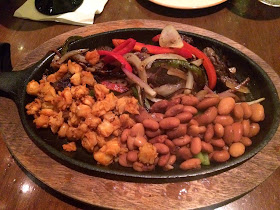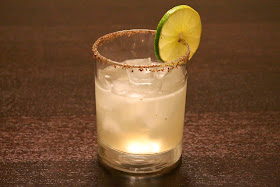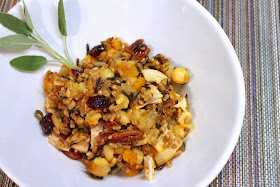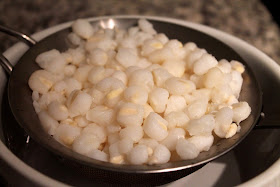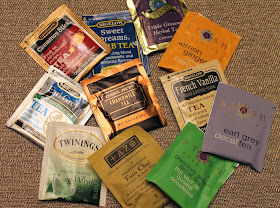 |
| Bryce Canyon National Park is a beautiful place, but you can't eat it. To find out what you can eat near this and other nearby national parks, read on. |
During our recent trip to national parks in Northern Arizona and Southern Utah it was hard to take a bad picture. The Grand Canyon, Zion, Bryce Canyon and Canyon de Chelly are so incredibly scenic that any amateur can take postcard-worthy shots.
Also hard to do in this region? Find a good meal. Given that the draw is nature and not cuisine, it seems the latter is often an afterthought. The little towns that have sprung up as motel villages near each of these parks offered up a lot of over-priced, bland food delivered with indifferent service. Nonetheless, we were pleasantly surprised by some good and even a few great meals on the trip. Here's a rundown of the good, the bland and the ugly.
 |
| Plaza Bonita steak fajitas |
Near Grand Canyon
The most popular national park we toured drew an amazing international mix of visitors, young and old alike. With such a diversity of potential customers, it's perhaps surprising that the Grand Canyon vicinity offers about the least interesting choices of restaurants. The motel town just south of the park, Tusayin, is dominated by fast food and steakhouses with decidedly nonplussed Yelp reviews. So, we steered clear of those places in the evening and instead headed to the town's Mexican restaurant,
Plaza Bonita. It's immediately familiar--the kind of colorful, family-oriented Mexican restaurant with tacos, burritos, enchiladas and fajitas. Coming from D.C., where this type of restaurant is too frequently just mediocre, Plaza Bonita's food was surprisingly good. The fajita steak was marinated and flavorful, served with the kind of refried beans and Mexican rice that I love but don't often see at home. We also really liked the restaurant's basic Original Margarita, which leaves no doubt as to whether it contains tequila. Perhaps because we each knocked back two of these, our bill was a bit higher than we were expecting--something we had to get used to around the parks--so if you're expecting typical suburban Mexican restaurant prices, adjust those expectations upward a bit.
 |
| Brisket and sides at Big John's Texas Barbecue |
It's a long drive between the Grand Canyon and the parks in southern Utah. There aren't a lot of towns, let alone good food options. But we did find a really great place to stop for lunch in Page, Arizona.
Big John's Texas Barbecue is rather nondescript-looking from the inside and the outside, although the large black smoker out front--which they use to smoke their meats with mesquite and oak wood chips--should be a clue that you're for something special. The brisket is fantastic--tender and smoky. We made a great meal with that and a couple sides. We so enjoyed Big John's on our way from Grand Canyon to the Utah parks, that we stopped in again on our way to New Mexico and tried the pulled pork and chicken sandwiches, which are served simply on a soft bun, and were just as tasty as the brisket. Big John's doesn't sauce their meat ahead of time, letting you apply as little or as much as you want of their spicy tomato sauce at the table. For sides, they offer the basics: a wonderful coleslaw dressed with just enough dressing and flecks of celery seed, a creamy old-school potato salad and cowboy beans. The food comes out pretty fast, but they also provide roasted peanuts at the table while you wait.
 |
| Zion National Park |
Near Zion and Bryce Canyon
Unlike Tusayan, Springdale, Utah, the town near Zion National Park, actually feels like a real town, with charming shops and restaurants lining the highway that snakes south from the park's entrance. Unfortunately, that didn't mean it was necessarily easier to find a good meal. I had high hopes for
Cafe Oscar given its good Yelp rating and the half-hour line of people waiting to get in. The food was pretty good; I enjoyed my Salmon Filet Salad with a nicely cooked piece of fish and appreciated the addition of pistachios for crunch. However, we were disappointed the appetizer we ordered never arrived, and our server never returned to our table until it was time for the check--at which point it was too late to do anything about the forgotten appetizer. Perhaps we just hit Oscar's on an off night. I could imagine that sitting on their outdoor patio as the setting sun turns the Zion rocks a vivid orange-red could be a great way to unwind after a day of hiking. But we were motivated to find a different place to eat dinner our second night in Springdale.
 |
| The Flying Monkey's sausage pizza |
We had a much better time at
The Flying Monkey, the local pizzeria serving delicious wood-fired pizzas. We chose the sausage pizza, which sounds plain but actually includes fire-roasted red peppers, fennel and a mix of mozzarella and romano cheeses, a great combination sitting on a nicely charred and chewy crust. We also had the chance to sample some locally made beer, the Full Suspension Pale Ale brewed in Salt Lake City by Squatters Brewery. Our service here was attentive and we enjoyed the relaxed, contemporary vibe of the large, open space.
 |
| Rustler's Ribs at Ruby's Inn |
Unfortunately, Bryce Canyon City is more like Tusayan, if not worse. The entire town is basically owned by one family, creating a virtual monopoly on not only where you'll sleep, but where you'll eat too. Not wanting to spring for the cowboy-themed dinner theater, we opted for
Ruby's Cowboy Buffet and Steak Room, which offers a buffet for $22 plus steak and other simple entrees served with two vegetable sides in that general price range (steaks are more, some of the other dishes like pork chops are a little less). If ever I felt like a trapped tourist, it was at Ruby's. This is pretty plain fare for this much money. Our ribs were decent and falling-off-the-bone tender, but the over-whipped mashed potatoes and limp, unseasoned vegetables were both uninteresting. The place was very busy and friendly but clearly overworked server didn't have much time for us. Bryce Canyon presented one of the starkest contrasts between our enjoyment of the view (see the first photo above) and the food.
 |
| Garcia's Navajo taco |
Near Canyon de Chelly
Our last park was Canyon de Chelly National Monument, a beautiful Y-shaped canyon in northeast Arizona carved from sandstone. One of the canyon's unique features is the ruins of the Anasazi Indians who lived in the area 700 years ago. Today, the area is home to the Navajo people; the best way to experience Canyon de Chelly is with a Navajo guide, who can tell you about the park's history and geology while also sharing personal stories about the area. Canyon de Chelly isn't as popular as the other parks we visited, but it's no less interesting. It's nice, actually, that there aren't as many people in this beautiful, peaceful place.
The nearest town, Chinle, is probably where you would stay to visit Canyon de Chelly, and its food options are limited in the extreme. We ate at
Garcia's because it was connected to our hotel and, based on available reviews, appeared comparable to the town's other full-service restaurant, Junction Restaurant. Dinner at Garcia's was fine. I had the Navajo Taco, a generous piece of Navajo fry bread topped with chili, lettuce, olives, onions and cheese. It sounds like heartburn-on-a-plate, but it was actually pretty satisfying. Even better was Garcia's breakfast: standard, but well-prepared fare like eggs and pancakes and really decent hash browns. The service, however, needs attention, as during both meals the restaurant seated us but then waited far too long to send someone over to take our order. Inside the park, we ate lunch at the
Sacred Canyon Lodge, a cafeteria-style place that's convenient for a quick bite. Hoping for some authentic Southwestern fare, I had the posole, a pork and hominy stew that I expected would be spicy but was actually surprisingly bland (I would get good posole in Santa Fe, which I'll discuss tomorrow).
 |
| Sonoran Salad at Bryce Canyon Lodge |
Inside the Parks
While getting good food near the parks can be hit-and-miss, inside the parks, lunch in one of the park's old lodges proved to always be a great choice. All of them offer something similar: a comfortable setting in an old lodge and a satisfying menu with a selection of sandwiches and salads just right for a restful lunch after a few hours of hiking. In the Grand Canyon, we stopped for lunch at the
El Tovar. Built in 1903, the majestic lodge has a view of the canyon from the Historic District along the south rim. El Tovar's club sandwich, made with brie, horseradish garlic mayo and duck bacon was unique and satisfying. The
Red Rock Grill doesn't have the historical feel of some of the other park lodges, but it's still a beautiful setting with a similarly solid lunch menu. Our favorite was the lunch at
Bryce Canyon Lodge, where I had the Sonoran Salad with grilled chicken, corn, bacon and feta cheese, and Chris had the club sandwich with smokey turkey, ham, bacon, swiss cheese and a wonderful sage aioli. The service at Bryce Canyon Lodge was also the best of the three park lodge restaurants, although all of them were friendly and welcoming.
 |
| Grand Canyon National Park |
Despite some uneven meals, I cannot complain overall. And while it's definitely true that you go to this part of the country for the scenery and not the food, there are still some great eats to be had if you know where to look.
Best bets: Big John's Texas Barbecue (Page, AZ), The Flying Monkey (Springdale, UT), Plaza Bonita (Tusayan, AZ), park lodge dining rooms (various).

























